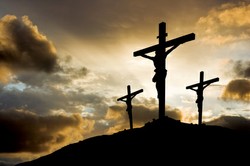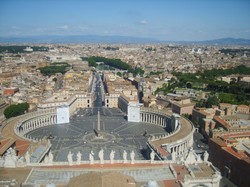There were many gospels, of which only four were accepted as canonical, which means authorised as an expression of the church's faith in Christ, and at the time of authorisation there were doubts about the authenticity of John's Gospel. Other gospels were rejected by the church because they felt that these gospels, sometimes known as Gnostic Gospels, either did not come from a source that was recognized as apostolic, or because they did not adequately reflect the church's faith.

Who Wrote the Gospels
by frankbeswick
We cannot know with certainty who wrote the four canonical gospels, but there are claims about their authorship which can be historically assessed
The Gospels and the Kerygma
There were many gospels written over a period of two or three hundred years. They range from serious attempts to give an account of Jesus' life to the purely fanciful. There is one that purports to deal with Jesus' journey through the underworld in the days between resurrection and ascension, and no one took this seriously. There are different views underlying each gospel. The four that we accept take an orthodox Christian view, but there were Gnostic gospels, which reflected the views of the Gnostic movement, and docetic gospels, which reflected a theology that regarded Jesus as a divine figure in merely human guise, which disagrees with the Christian view that he was fully human and fully divine.
The last of these gospels to be written was the gospel of Barnabas, which was written as an adaptation of a fragment of an earlier Gnostic gospel in 1600. The only people who take its claims seriously are fundamentalist Muslims, as it presents an Islamic view of Jesus, while serious Muslim scholars concur with Christians in seeing it as apocyphal.
There is also Tatian's Diatessaron, which was a well-intentioned attempt to produce harmony of all four gospels written in the late second century. Tatian added nothing to the text, but the church decided that his work could not be considered authoritative as it was basically second hand and it wanted to keep the canonical four gospels.
The four canonical gospels have two distinguishing marks. They either come from an apostle or a source close to one or more apostles; and they all have a kerygmatic structure. C.H. Dodd, an eminent Bible scholar, calls them commentaries on the kerygma. Thje kerygma is the early preaching of the church. Luke gives us Peter's kerygma in Acts 2 and Paul's in Acts 13, his intention being to show that Peter and Paul preached substantially the same message. We also have some of the kerygma in Acts 7, but, as Stephen was murdered halfway through his preaching, we do not have it all. The message is
Jesus Christ, a man approved by God by his holy life
[Peter includes miracles, Paul does not]
Taken and crucified by sinful men
Risen by God's power on the third day
Acclaimed as king and Lord
Salvation is through him.
The kerygma is earlier than the written gospel, which serves to fill it out with detail.
This raises the problem of Thomas. The gospel of Thomas has never been accepted as canonical, and it seems to have been forgotten until it turned up in a set of scrolls found buried in Egypt. It does not have the kerygmatic structure of the others, and it is most likely Gnostic in doctrine, but many scholars think that it as as early as the canonical four and could come from a source close to the apostles. It belongs to a type of early Christian literature which faded out of fashion as the gospels were written: lists of Jesus' sayings. It is likely that many are genuine sayings of Jesus, but we cannot tell which ones.
gospel music
 | WOW Gospel 2013 2013 two CD collection containing 30 of the year's top Gospel artists and songs. Includes cuts from Kirk Franklin, Anthony Brown, Israel & New Breed, Smokie Norful, Andrae Crouc... |
 | Best Days 2012 album from the Gospel vocalist and actress, best known for her work with Tyler Perry. With Best Days, the acclaimed actress and Dove award-winning vocalist shares the joy t... |
The priority of Mark
The problem is that no evangelist [name for a gospel writer] added his name to the gospel. So we only know the names of the supposed writers from an early source, Papias,an Anatolian bishop who died in 155 A.D. He was the author of a sayings document that has only survived in fragments, but seems to be close to the sayings in Matthew and Luke. Papias reports the names Matthew, Mark, Luke and John, saying that Matthew write the first, which is almost certainly a mistake and that John wrote the last to fill in the gaps left by the others, which is an even bigger mistake.
Scholars divide the gospels into the Synoptic gospels and John, the name synoptic meaning with one eye. This is because the three of them are remarkably similar, though they differ in some ways.
Mark is definitely the earliest, and Matthew and Luke seems to have copied it by including it in their gospels, while adding material of their own. Papias says that Mark was the Ammanuensis [secretary] to Peter at Rome and write down Peter's preaching as he remembered it. This seems to present Mark as a jumbled document, which is unfair, as it has a clear structure, and many have regarded it as a passion narrative with an introduction, as the Passion takes up about a third of the gospel. Some suggest that it was inspired by an earlier passion document, though this is not universally agreed. Sayings are few in Mark compared to Matthew and Luke and the emphasis is on Jesus' deeds.
The oddity of Mark is that it has no infancy narrative and a truncated resurrection narrative. It is easy to explain the lack of an infancy, as if it was the testimony of Peter, Peter did not witness the events of the infancy, and so in honesty he could not give an account first hand. The lack of an infancy is testimony to the honesty of the gospel.This would also be the case were it to be the testimony of another apostle.
The truncation of the resurrection narrative is harder to deal with. There are long and short endings,which seem to have been added to the text, which stops at the empty tomb. Maurice Casey, professor of Aramaic at Nottingham, suggests a new theory. He believes that the gospel was written in Judaea,quite early on and not long after the death of Jesus, but its author had died just before completing it. But the status of the author was so high that his incomplete work was preserved. Casey also notes evidence of Aramaic speech behind the Greek of the text, which testifies to the claim that the gospel was reporting the speech of Jesus, whose native language was Aramaic.
I am going to make a suggestion, it is not one made by any academic scholar, but if Casey is right and we are looking at an earlier Judaean source as the writer of this gospel, we need to look no further than one whose life was shortened rather dramatically by being beheaded by Herod Agrippa, who reigned between 41 and 44. After Judas, the first apostle to die was James the brother of John. The work of the one of the three core apostles would have been worth preserving, even if unfinished. In fact, its lack of finish could be explained by his execution. While the traditional date for the gospel was about AD 70 in Rome, that date might have been the time of the translation of the Aramaic original into Greek.
Gospel
 | The Gnostic Gospels of Thomas, Mary & John Collected here are three gnostic writings from Thomas, Mary, and John. These books that were left out of the New Testament shed light on the life and relationships of Jesus Chri... |
Matthew and Luke.
These two gospels are based on Mark, which was regarded as authoritative. Each author took Mark and worked it into his gospel. This would only have been done if they thought that the author of the gospel had high status in the apostolic community. But they also worked in a document known as Quelle [Q] a list of Jesus' sayings. As sayings lists were not unknown at the time, this source must have been considered authoritative and from a reputable source. Matthew has been proposed as the author of this source, but not all scholars concur on this.
Matthew and Luke also include some material unique to their gospels, and this material is known as sondergut, and is given the titles M and L respectively.
Short of finding a gospel signed with the author's name, we cannot know for certainty the names of the writers of these gospels. We have only tradition to rely on.
However, the case for Luke is stronger than the case for Matthew. The gospel of Luke has a sequel, which is written in a style similar to the gospel, Acts of the Apostles. Each of them begins with an address to an imaginary person, Theophilus, which means lover of God, and the Acts begins as the gospel leaves off and the author talks of "my earlier work." Furthermore, in the later parts of Acts the writer begins to talk not only about Paul, but about "We" when speaking of Paul's journeys, and we know that he took Luke with him. Luke, a doctor, was needed, because we know that Paul had medical problems [and there is all sorts of speculation about what they were, but no one knows.] Unless you are one of those intellectuals who likes to believe that no one wrote the books attributed to them, the case for Luke appears strong.
But while Matthew clearly was an apostle and therefore a witness to Jesus, Luke was not, so does this undermine his credentials? Luke sees the difficulty and so at the beginning of his gospel he states that many had written accounts of what happened and that he had gone over these accounts [drawn on the sources] to write his account. This is interesting, as Luke wrote about 70-80 AD, and yet he is testifying to to the presence of unknown documents that others had written. There may hopefully be much of interest to discover yet in the sands of Egypt or in the Villa of the Papyri at Herculaneum.
Synoptic Gospels
 | The Synoptic Gospels, Revised and Expanded: An Introduction Keith Nickle provides a revised and updated edition of a well-respected resource that fills the gap between cursory treatments of the Synoptic Gospels by New Testament introduct... |
John
This is a fascinating document written by one of the leading intellectuals of the early church. Scholars varied in their opinions, but agreed that it was the last to be written. Some scholars thought that it was written about AD 90, but others went as late as 130. This latter date is not now regarded as probable, but there are some who think that it belonged to the second century. Yet as Papias, who died in 155 mentions it, it cannot be later than that date.
Yet talk of a date is otiose, as the gospel underwent an evolution and was written in several stages. C.H. Dodd thought that it began about 60AD, while Raymond Brown, an expert on John, goes for an early date about this time. The reason is that whoever wrote it seems to have had a knowledge of Jerusalem as it was before the destruction in AD70, and he shows some knowledge of the details of the arrest that indicate some genuine acquaintance with the events. He speaks of the Chiliarch [commander of a thousand] being present, and this was the correct description for the officer commanding the cavalry unit based at Jerusalem. Also he tells that Jesus was pierced by a lancea, the weapon that was used by this unit. As a date of 130 was sixty years after Jerusalem was destroyed it is unlikely that detailed knowledge of its layout would be likely to someone who had not been there, so an earlier date seems the more likely.
Yet even if the first stage was early, there were later stages. It is likely that chapter 11 was inserted later. This deals with the raising of Lazarus, but this chapter gives a clue as to the writer. The inspiration for the gospel was the man whom Jesus loved, and Lazarus is in this chapter described as the man you [Jesus] love. Robin Lane Fox thinks that Lazarus was either the writer or the inspiration for this gospel.
Yet chapter 8 is an insert. This deals with the woman taken in adultery, who Jesus spared the death penalty. Apparently this was an independent tradition which floated about for some years, being sometimes inserted in Luke until it finished up in John, where it does not really fit. It was too important to overlook and it needed to be in a gospel.
The final chapter seems to have been pegged on as an extra, as it is preceded by what appears to be an original ending to the gospel, which then duplicates an ending. Thius indicates that whoever added to the gospel had too much respect for the author to take anything out of his work, but felt a need for an addition.
Interestingly the style of the discourse in John is identical to the style of what is known as the first letter of John, so they must have come from the same author, but the letter is not signed and so it does not enable us to conclude anything about th authorship of either.
Pagans and Christians
 | Pagans and Christians From the second century AD to the conversion of the first Christian emperor, Constantine, Robin Lane Fox's "Pagans and Christians in the Mediterranean World" gives a fascinating... |
Conclusion
There is no certain knowledge in history, so we cannot know with certainty the authorship of any gospel. But this is a two edged sword, as we cannot say with certainty that Matthew or Luke, for example did not write their gospels. The strange practice of some academics of declaring that a specific gospel or letter was written by an anonymous Christian is not credible, as the word anonymous means nameless, and is merely a way of saying "I don't know who wrote it" and sounding wise at the same time. If you don't know who wrote it, how can you be certain that it was not the one reputed to have written the gospel? The correct attitude to take is critical openmindedness. I take seriously traditional sources like Papias, but not uncritically.
You might also like
Who was JesusTo understand Jesus you must realize that he was a mystery that theology trie...
Ministry in the church:women bishopsThe long awaited decision to have women bishops is major progress.



 TheThousand Year Gardenon 11/26/2025
TheThousand Year Gardenon 11/26/2025
 Women of the Gospelson 10/11/2025
Women of the Gospelson 10/11/2025
 Religious Gardenson 08/25/2025
Religious Gardenson 08/25/2025
 Doctor of the Church: John Henry Newmanon 08/03/2025
Doctor of the Church: John Henry Newmanon 08/03/2025



Comments
True, but what follows
Thank you!
The comment below in answer to my previous, same-day observation and question is most elucidating.
God selected names -- unlike Derdriu ;-D -- that were recognizable and relatable.
Nothing like having to work through difficult, unpredictable, unusual pronunciation and spelling before all else, right?
Jesus,Jooseph and Mary were common names at that time. In choosing them God chose to sanctify the ordinary.
Thank you!
Mary appears as a commoner name than I anticipated. It calls to mind:
Mary sister of Jesus Christ;
Mary sister of Lazarus and Martha;
Mary Magdalene follower of Jesus Christ;
Our Lady Mary His mother.
English Wikipedia considers other women named Mary in its article New Testament people named Mary:
Mary mother of Gospel author John Mark;
Mary mother of Joseph;
Mary of Clopas;
Mary of Rome as St. Paul's kindly acquaintance.
Might there be more?
The Gospel of Philip is not accepted as genuine by the church. It is a Gnostic gospel written after the canonical gospels.
Thank you!
English Wikipedia equates the Gospel of Philip with the furnishing a sister of Jesus Christ with the name Mary.
The aforementioned source, in its article on the Gospel of Philip, indicates a "special relationship" that invoked special "insight" into Jesus Christ's teaching.
The above-mentioned article mentions likewise regarding the Gospel of Mary and the Gospel of Thomas.
What might that "special relationship" be?
Probably. But the organisation and cataloguing of the library is a lifetime's task and more for a multilingual scholar adept in Latin, Greek, Aramaic and Hebrew. Good luck to anyone who tries it.
Some online sources consider a Gospel by Mary.
English Wikipedia tentatively identifies that manuscript as by Mary sister of Jesus Christ, Mary Magdalene His follower or Our Lady Mary His mother.
The aforementioned source mentions one version in Coptic and two versions in Greek.
Might the Vatican libraries preserve some such fragments?
The call of james and John would be the signature event.
frankbeswick, Thank you for practical information, pretty pictures and product lines.
Your subheading The priority of Mark contains interesting material upon which to reflect.
Is the gospel attributed to Mark because of his work as secretary? In particular, I like your suggestion of authorship by John's brother.
What would such an authorship do to an explanation somewhere that each gospel author put his own signature event in his gospel (Matthew and tax collectors, Mark and the young boy, Luke and the doctor healing himself, John [and Mary at Ephesus?])?